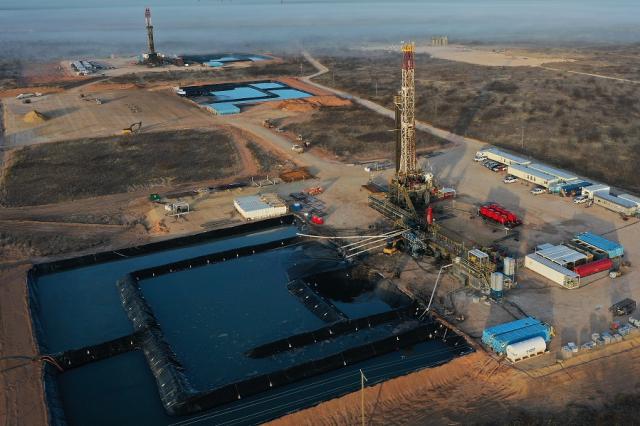
Permian Basin pure-play Vital Energy intends to aggressively pay down debt following a trio of deals totaling $1.165 billion that add much-needed inventory in the Midland and Delaware basins. (Source: Shutterstock.com)
With a hefty $1.165 billion price tag, Vital Energy doled out plenty of equity and cash (and added debt) to acquire assets from three Midland and Delaware basin E&Ps — but analysts said the transactions bulk up on sorely needed inventory.
“It’s a good play by Vital,” said Enverus Intelligence Research Director Andrew Dittmar. “They had the shortest runway of inventory of any public company we track.”
On Sept. 13, Vital Energy said it would snag assets from three Permian Basin private producers in a cash-and-stock deal that essentially doubles the equity of Vital Energy, which has a market cap of about $1 billion.
Sellers included Henry Energy LP, Henry Resources LP and Moriah Henry Energy Partners LLC; Tall City Property Holdings III LLC, backed by private equity firm Warburg Pincus; and Maple Energy Holdings LLC, which is affiliated with private equity firm Riverstone Holdings LLC.
Vital Energy knitted up some of the few remaining private opportunities in the Permian, he said.
While the deal dilutes the company’s EBITDA, Dittmar said the transactions were “worth it to extend inventory,” Dittmar said, speculating that the Permian could see a rush by “public operators to grab these even small opportunities that are left.”
Other analysts noted that Vital Energy’s deal dilutes shareholder equity but is still accretive to free cash flow yield. The company said free cash flow will increase by approximately 90% by 2024.
The acquired leasehold matches up well with the company’s two previous 2023 acquisitions, Jason Pigott, Vital Energy’s president and CEO, told analysts on a Sept. 14 call to discuss the deal.
In April, the company added Midland acreage through its $214 million purchase of Driftwood Energy Operating LLC. Then in June, Vital Energy entered the Delaware through a $378 million deal to acquire 70% of EnCap Investment Partners’ Forge Energy II.
Pigott noted that each of the three new transactions complements its Forge acquisition and will create a large contiguous acreage position in Reeves County, Texas.
“We'll have about 70,000 net acres in the Delaware,” Pigott said.
Heavy on the equity
The transactions include $569 million in equity, $296 million of convertible preferred securities and about $300 million in cash, Gabriele Sorbara, managing director of equity research at Siebert Williams Shank & Co. LLC, wrote in a Sept. 14 report. The company will also offer up to 2.875 million shares to pay down a portion of borrowings as well as $800 million in senior notes.
“In the current price environment and given the slightly oilier production mix, the $1.165 billion price tag is reasonable at $33,286 per flowing boe/d of production (a 19.5% premium to VTLE’s pre-deal of $27,854),” Sorbara said. “At our price deck, we estimate the combined PDP value [at] around $1.1 billion (roughly in line with the company’s estimates), just under the transaction price tag.”
The company’s acquisition of about 115 net locations cost an estimated $500,000 per well, Sorbara said. Vital Energy management said the company plans to decrease activity on its acquired assets by about 50%.
Upon closing, Vital Energy said it would have more than eight years of inventory at its expected operational pace.
Dittmar said that pro forma, the deal likely extends Vital Energy’s runway of sub-$50 inventory by about four years.
On the analyst call, Vital Energy management noted that the company has a track record of underwriting assets with a conservative approach and adding inventory over time. In the acquisition of Driftwood’s assets, for instance, the company sees the opportunity for multiple benches that weren’t underwritten as part of the deal or announced.
Debt reduction
Including the most recent deals, Vital Energy’s M&A tab so far this year is $1.757 billion.
Pigott and Vital Energy management said they will aggressively focus on repaying debt.
“We expect that our 2024 adjusted free cash flow will increase by nearly 90% at $80 [WTI] oil,” he said. “We have hedge volumes associated with these deals to ensure returns, cashflow, projections and the achievement of our leverage targets.”
The enhanced cash flow and resulting capital structures from the deals will “rapidly accelerate debt reduction” as well as create scale and synergies in the Permian.
Vital Energy anticipates decreasing pro forma leverage to less than 1x by year-end 2024 at $80 WTI, Pigott said.
“In addition, our borrowing base increases and [that] we help ensure access to capital at more attractive rates,” he said. “As we push leverage below our 1x target, we expect to initiate a competitive cash return program for shareholders.”
Concurrent with closing the deals, Vital Energy said its credit facility borrowing base will increase to $1.5 billion and its elected commitment to $1.25 billion. The E&P will have access to the full $1.5 billion borrowing base through a committed $250 million term loan facility.
The acquisitions also add more than 50,000 net acres and 35,000 boe/d, of which half is oil.
Pigott said the transactions add “scale, which is critical in today's energy sector.”
Overall, the company, upon closing, will have amassed 250,000 net acres with anticipated 2024 production averaging 112,000 boe/d—or “25% higher than where the company would have been on a standalone basis,” Pigott said.
The increased production will nearly double free cash flow, Pigott said.
“We'll be bigger, better and more sustainable on the road ahead,” he said.
Recommended Reading
Keeping it Simple: Antero Stays on Profitable Course in 1Q
2024-04-26 - Bucking trend, Antero Resources posted a slight increase in natural gas production as other companies curtailed production.
Oil and Gas Chain Reaction: E&P M&A Begets OFS Consolidation
2024-04-26 - Record-breaking E&P consolidation is rippling into oilfield services, with much more M&A on the way.
Exxon Mobil, Chevron See Profits Fall in 1Q Earnings
2024-04-26 - Chevron and Exxon Mobil are feeling the pinch of weak energy prices, particularly natural gas, and fuels margins that have cooled in the last year.
Marathon Oil Declares 1Q Dividend
2024-04-26 - Marathon Oil’s first quarter 2024 dividend is payable on June 10.
Talos Energy Expands Leadership Team After $1.29B QuarterNorth Deal
2024-04-25 - Talos Energy President and CEO Tim Duncan said the company has expanded its leadership team as the company integrates its QuarterNorth Energy acquisition.





